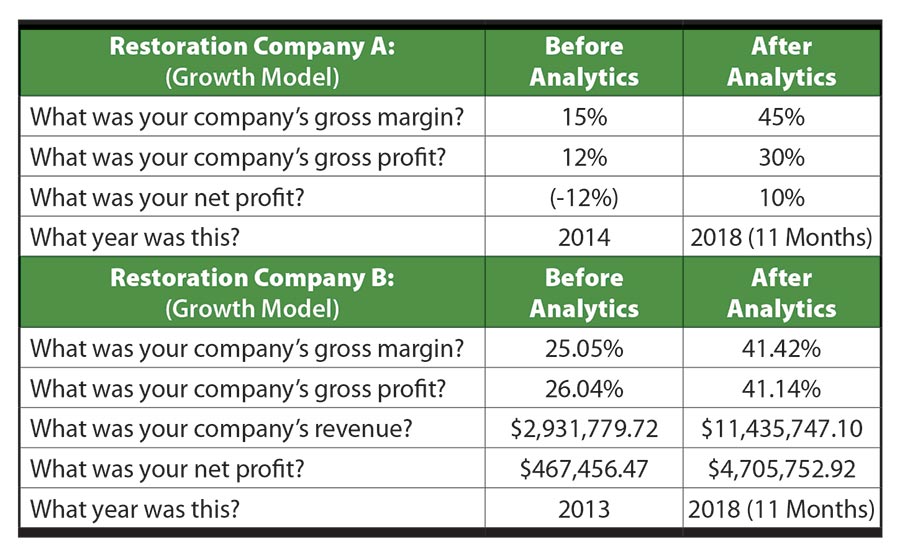Regaining Profits in Restoration Through Technology

It’s hard for some businesses to imagine living in today’s digital age. Many businesses still collect information on paper or through multiple software solutions, but the manual process of transferring information from one place to another severely limits a company’s ability to act—much less drive efficiency, performance, and profit.
A study conducted by two philosophers in the 1970s tried to identify what caused people to fail in achieving goals in the workplace. To summarize their results, they identified two main factors. The first was ignorance, or the lack of knowing/ understanding. The second was ineptitude, meaning knowledge existed, but information could not be accessed or applied correctly to the required actions. Looking at insurance in the restoration industry, there was a lot of effort put forth on collecting information. So, the problem wasn’t the lack of data, but rather what to do with it all— complexity is, after all, the enemy for all business-related activities. Even the best of us can mentally freeze up when hit with several different requests while trying to sift through an avalanche of raw data. But what does this lack of visibility cost your business today?
If you consider the average wage of your lowest-paid employee per hour and the unproductive time spent searching for information, as little as 30 minutes of unproductive work each day costs your business thousands annually per employee. Statistically, the average worker in an eight-hour shift produces just under three hours of actual productive time. The rest of that time is spent reviewing, planning, communicating, and analyzing what needs to be done. As a company begins to scale, what once worked on paper or through manual processing becomes impossible to manage due to the increase in volume. This ends up costing businesses significant amounts of time and money with these losses of efficiency and increases in administration.
However, throwing more resources at such a problem doesn’t necessarily resolve the underlying issues, it only masks them temporarily as the business grows. It also breeds a “reactive” culture, one that is constantly trying to catch up. You know what this is if you’ve ever had the feeling like your staff is overworked, stressed to the max, and busy but never getting ahead. This article focuses on taking a different approach to regaining profitability through proper utilization of technology using the three main pillars of data: management, analytics, and visualization.
Step One: Management
Simply put, most companies understand the value of a good management tool. Systems like PSA Restoration Contractor provide contractors with organization, centralized input, and quick access to critical details on demand. Information drives behavior, so it must be easy in order to utilize it at an entry level to extract meaningful data at the top. Today’s companies surround themselves with a number of various systems in an effort to streamline workflow, costing, compliance, and client satisfaction. However, due to the sheer volume of systems in place, none of which communicate together, information is duplicated, missing, or contains gaps. Systems must be simple, intuitive, and integrated into the core insurance ecosystem in order to deliver value. Companies invest significant capital and time on implementing, training, and maintaining their systems. Despite the benefits that these technologies can provide, they are still just a tool—one that requires people to manage and maintain. Technology can be a great asset, but it’s only as powerful and as accurate as the information you put into it.
Step Two: Analytics
Now we have gone from ignorance to more information than we can manage. The goal of this exercise is to gain access to the right information, not spend time trying to look and find what is important. This pain can be described as a commonly known syndrome called “DRIP” or “Data Rich, Information Poor.” For years, companies have been collecting and analyzing data to determine trends, track progress, and measure performance. In most cases, this requires staff to extract, massage, and clean data in order to get it into an understandable format. Due to the nature of the industry, most companies intuitively operate from a “reactive” standpoint rather than one focused on execution. This results in forcing people to look back through historical information to reflect on what went wrong in the past rather than taking a proactive approach at the beginning and driving positive results.

The result of great data analytics is what can be known as “actionable insights” which provide businesses with enough data to make well-informed decisions during production. These are direct, meaningful actions that can be taken from analyzing any type information. It has only been within the past few years that business intelligence tools such as Microsoft BI have become more mainstream and allow companies of any size build their own analytics and provide visualization to the people who are doing the work. This provides individuals with the ability to see the entire process at a glance, set goals, and work toward breakthrough results.
Step Three: Visualization
If you can’t see it, you can’t measure it, you can’t improve it. Management thinker Peter Drucker is often quoted as saying, “you can’t manage what you can’t measure.” Drucker means that you can’t know whether or not you are successful unless success is defined and tracked. In many cases, companies provide their teams with the necessary tools to collect information, however they make it difficult for those teams to set goals and measure performance against it in real time. The age of the status box and printed report is a thing of the past. People no longer want to see historical information, they want to visualize it as it happens in real time. As owners, they need to be able to check the pulse on their business to understand how they are performing both operationally and by profitability. Companies are in business to make money, and management needs the ability to understand what is slipping through the cracks and how it can improve at a very high level. By leveraging technology, we can get actionable insights into the hands of the people doing the work—driving efficiency, performance, and profit in the right direction. What activities are providing the most revenue? What activities result in higher customer satisfaction? These are questions business are always asking, but rarely are they able to see and understand the answer.
Businesses are building workforces today to work smarter, not harder.
Having the right tools in place is critical, but without clear direction, goals, or the ability to measure and track performance, how can businesses expect to regain profitability in an industry that puts so much emphasis on information and the power it can provide?
Looking for a reprint of this article?
From high-res PDFs to custom plaques, order your copy today!






